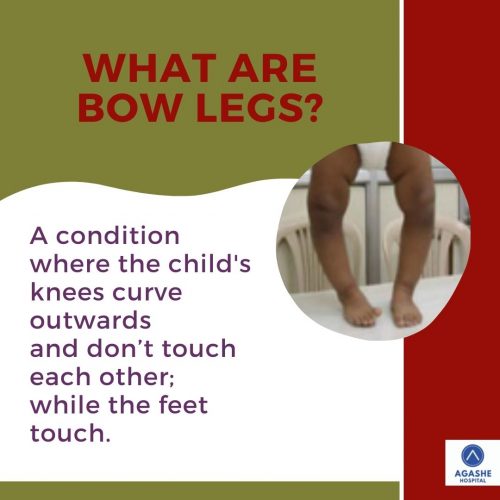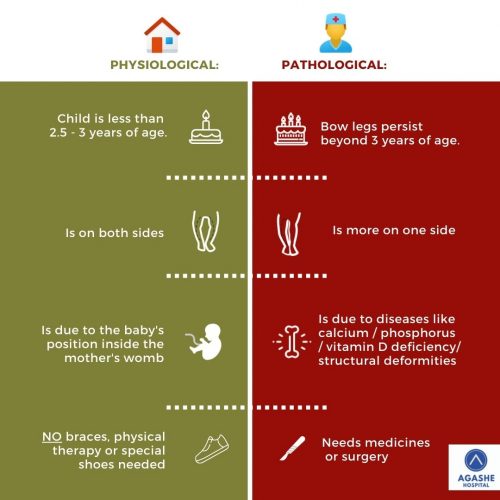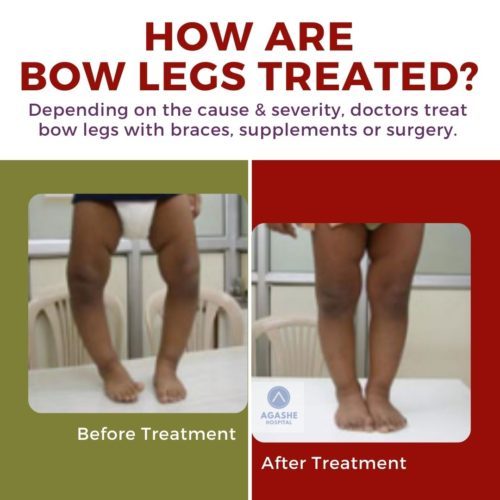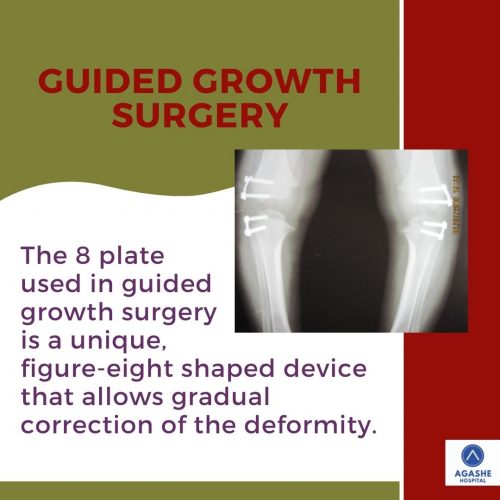Bow Legs

What are Bow Legs?
Bow legs (called Genu Varum by doctors) is a condition in which a child’s legs curve outwards at the knees. When a child with bow legs stands erect, their knees don’t touch each other, while their feet do. It is common under 2 years of age but children usually outgrow this condition after 18 – 24 months of age.
What are the symptoms of Bow Legs?
- The knees are curved outwards
- The child may have an awkward walking pattern
- The child may trip frequently or be clumsy
- The child’s toes may point inwards (called in-toeing or pigeon toes)
Dr. Mandar Agashe, Paediatric Orthopaedic Doctor in Mumbai says, “Bow legs usually do not cause any pain or discomfort in younger children. They do not affect a child’s coordination or ability to walk or run either. Neither is it associated with a delay in learning to walk.”
What causes Bow Legs?
- Part of Natural Growth:
Some babies are born with bow legs. Pediatric Orthopedic doctors believe that this happens when the baby does not get enough space in the womb as it grows. As a result of this, their bones twist slightly to fit into the tight space of the womb. Some kids develop bow legs in their first year of life as a part of natural growth. Most of these kid’s legs straighten out as they grow and begin to stand and walk.
- Conditions:
Blount’s disease is a condition where one or both of your child’s shin bone grows abnormally leading to a sharp curve below the knees. This condition does not resolve over time, but grows worse. This condition is more common in children who are over-weight or start walking at an early age or have a family member who had the condition.
Metabolic disorders like Paget’s disease and rickets can also cause bow legs. When a child does not get enough vitamin D, calcium or phosphorus, it can lead to Rickets which causes their bones to get weak causing bowing. Conditions like injuries, infections or tumours around the knee may also affect bone growth and lead to bow legs. Paget’s disease is a condition which impacts the way a child’s bones undergo the routine recycling process leading to fragile misshaped bones.
Improperly healed fractures, damage to growth plate and achondroplasia (a type of dwarfism), abnormal bone developments (called bone dysplasia) and lead / fluoride poisoning are some other causes of conditions that cause bow legs.

When should you see a doctor for your child’s bow legs?
Bow legs may be a part of natural growth (called physiological by doctors), in which case one can just wait and watch. Or, it may be a disease condition that needs to be treated (called pathological). So how does one know which is which? If a child’s bow legs are associated with any of the below, the child needs to be shown to a Paediatric Orthopaedic Doctor:
- Bow legs persist even after the age of three years
- The bowing is more pronounced on one leg than the other
- The child limps when walking or has trouble running
- The child complains of pain in the hip or knee
- The child’s height is not growing as expected
How are Bow Legs diagnosed?
A Paediatric Orthopaedic doctor will examine a child who has bow legs to see if the angle of the child’s thigh bone to shin bone, direction of the knees versus the feet and range of motion of the hips are within the normal range.
An XRay may be advised in case Blount’s disease, Rickets or other diseases of abnormal bone development are suspected. Blood tests may be advised if Rickets or Paget’s Disease are suspected.

How are Bow Legs treated?
As mentioned earlier, physiological bow legs need not be treated.
- Children with Blount disease may require braces to correct the legs.
- Rickets is treated by adding Vitamin D and Calcium to the diet or by supplements if needed. Rickets may also arise due to genetic conditions in which case it needs specialised treatment.
- When bracing is not enough, surgery may be needed. In a growing child, a surgery may be used to help guide the leg to straighten as it grows. This is called as a guided growth surgery. This is done using a unique plate that is shaped in the figure of eight and allows gradual correction of the deformity. In adolescents whose bones have matured, a surgery called osteotomy may be needed to straighten the leg. These surgeries may involve inserting plates or rods or external fixators into the thigh or shin bones.
In some cases, one leg becomes shorter than the other due to bowing. In this case a limb lengthening surgery may be needed.

Can bow legs have any long term effects?
It has been found that adults who were not diagnosed or treated for bow legs earlier are more commonly found to suffer from knee instability or progressive knee arthritis. This occurs because of prolonged overload on the inner aspect and stretch on the outer aspect of the knee.
If you suspect that your chid has bow legs, do not hesitate to visit your Paediatric Orthopaedic Doctor who will guide you if you need to just keep an eye and wait for your child to outgrow their bow legs or whether it needs to be treated.
Expert Moderator: Dr. Mandar Agashe, Paediatric Orthopaedic Doctor | Author: Dr. Amrita Sodhi







